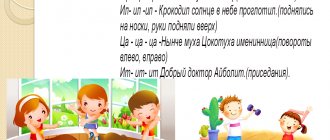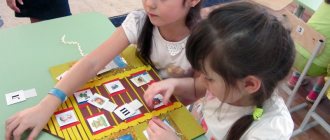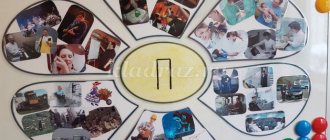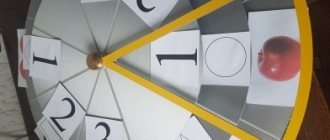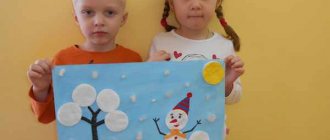Card index of games based on fairy tales
Progress of the game:
A fairy tale is chosen for adults (this may be a fairy tale that is currently being studied). The presenter takes one of the heroes of the fairy tale and describes him: he tells how he looks, good or evil, big or small, what he does during the fairy tale, etc. After that, he asks the children to repeat what he said.
Then the presenter takes another figurine and asks the children to take turns describing the hero and make sure that the descriptions are not repeated.
If this does not work, the presenter asks leading questions: for example, what is the grandfather wearing; is he old or young; what he does, etc. For correct answers, the child receives a token. The one who gives the most answers wins.
"Find by silhouette."
Purpose of the game: Development of speech, visual thinking, attention, figurative memory.
Material: figures of heroes from one fairy tale are used (“Turnip”, “Teremok”, “Kolobok”, “Hare and Fox (Zayushkina’s hut)”, etc.). You can use figurines of fairy-tale characters from the theater on flannelgraph.
Progress of the game:
The presenter asks the children to look at the figures from all sides. Next, he explains what a silhouette is and asks the children to trace the silhouette of the figure with their finger, and then with a pencil.
The presenter lays out the figures on the reverse side and asks them to find fairy tale characters and objects.
“Show me the same.”
Purpose of the game: Expand vocabulary. Teach children mental operations: comparison, generalization, logical thinking. Develop imagination, be able to classify objects according to different criteria.
Material: figurines of fairy tale characters from the theater on flannelgraph; pictures with plots of the chosen fairy tale.
Progress of the game.
The presenter talks about how there are identical objects, body parts in different people, animals, etc., and asks the children to show the same things.
Then he asks to answer his questions and show the same on the figures. For example, who has tails, who is dressed in skirts, how are grandfather, grandmother, granddaughter (they walk on their feet, people) similar, how are bugs, cats, mice (animals) similar, etc.
“Color according to the description.”
Purpose of the game: development of speech, the ability to listen to others, clearly express your thoughts; consolidation of the concept of “silhouette”; development of observation, imaginative thinking and imagination.
Material: figurines of fairy tale characters from the theater on flannelgraph; pictures with scenes from the game “Collect and tell a fairy tale”, the selected fairy tale; riddles for fairy tale heroes; colored pencils, paper.
Progress of the game.
The presenter tells the children a fairy tale and lays out supporting pictures with the plots of the fairy tale. Then, together with the children, he selects figurines of fairy tale heroes.
When the figures are in front of the children, an adult reads a riddle about one of the heroes from a card. Children must guess who we are talking about. The one who guessed first becomes the storyteller.
“Tell a fairy tale from a picture” Goal: To develop the ability to retell a familiar fairy tale based on illustrations. Equipment: Plot pictures for fairy tales or a series of plot pictures. Progress of the game: The teacher shows the child a story picture. The child names the fairy tale and describes what is depicted in it. If desired, the child can tell the story in full. “Who is the extra character?” Goal: To clarify children’s knowledge of the content of fairy tales and fairy-tale characters. Equipment: figurines of fairy tale heroes from various types of theater. How to play: The heroes of one of the fairy tales with one extra character are placed on the table. For children 5 years old, it's called a fairy tale. Children must name who is extra, who is lost. Children after five years old must name which fairy tale the heroes are from and who is lost. Lotto “Find fairy-tale characters” Goal: To develop the ability to recognize a fairy tale and its characters. Equipment: Large cards with the plot of a fairy tale; small cards depicting fairy-tale heroes of a fairy tale Game progress: Children have large cards with the plot of a fairy tale. The presenter shows small cards. The child, who has a hero from a fairy tale depicted on a large card, names the hero and takes him for himself. The first one to fill out his card wins. “Who gets it together faster” Purpose: To consolidate the content of fairy tales. Equipment: Figures of fairy-tale characters, illustrations of fairy tale plots. How to play: The plots of different fairy tales are laid out on the tables. Children are given figurines or illustrations of fairy-tale characters. Children dance to the music with their characters. At the teacher’s command, children find the desired plot and pose their own fairy-tale hero. “Name a fairy tale” Purpose: To consolidate the content of fairy tales and fairy-tale characters. Equipment: A playing field on which the plots of different fairy tales are placed in turn; cube. Progress of the game: The child throws the dice. Makes a move in accordance with the dropped number of points. Names the fairy tale he fell into and its characters. If he succeeds, he continues the game in order of priority. If he fails, he returns to the start. "What changed?" Goal: To consolidate the ability to distinguish and name fairy tale characters. Equipment: figures (illustrations) from a tabletop theater, from one or more fairy tales (complication). How to play: In front of the children are figures of heroes from one fairy tale (or from several). The names of the heroes are clarified. Then the children close their eyes and the teacher removes one toy. Children open their eyes and have to say what has changed. “Guess the fairy tale” Purpose: To consolidate the names of fairy tales and fairy-tale characters. Equipment: Cards depicting an excerpt from a fairy tale or a fairy-tale character. Progress of the game: the cards are turned over, the children come up in turn, choose a card, name a fairy tale or a character. If the answer is correct, the card is taken away; if not, it is put back in its place. At the end of the game, the winning cards are counted.
Aren't you tired? Then let's play some more!
“Didactic game as a means of introducing younger preschoolers to reading books”
A fairy tale arouses love and lasting interest in children with its dynamism, brightness of images, entertaining events, unlimited possibilities for imagination, invention, and mental games.
Children are interested in games in which fairy tale characters act. “Our guest is the hero of a favorite book” - a conversation game in which the teacher conducts a conversation not from himself, but from a character close to the children and thereby not only maintains playful communication, but also increases the desire to repeat the game. (photo6)
Interest in works of literature and folklore is supported by the games “Guess the hero by description”, “Who said it?” (learn words and dialogues from familiar fairy tales, poems), “Recognize a book by its cover”, “Guess a fairy tale by three words” (Alyonushka , kid, well - “Sister Alyonushka and brother Ivanushka”) (photo 7, 
The didactic content of the guessing game is that children are given a task and a situation is created that requires comprehension of the subsequent action. The game task is inherent in the title itself: “What will happen if all fairy-tale heroes live next to us?”, “Which fairy-tale hero would you choose as a friend?”, “Which fairy-tale hero would you like to be and why?”.
Nothing enriches the figurative side of children’s speech as much as small folklore genres. Among these treasures of oral folk art, proverbs, sayings, and riddles occupy a special place. With the help of proverbs, you can emotionally express encouragement, delicately express reproach, or condemn an incorrect or rude action. . Games with proverbs contribute to better memorization of folk sayings. “Which character does this proverb fit?”, “Finish the proverb.”
The rhythms and rhymes of folklore nursery rhymes, jokes, counting rhymes, and the poetry of folk tales introduce preschoolers to works of art. Games are designed to help you fall in love with poetry, teach you how to select a rhyme for rhythmic lines, and compose poems."By rhyme, remember the poem (goby-barrel, housewife-bunny), “Say a word” (an adult says a line of the poem without finishing the last word).
Thanks to games, children do not get tired of listening to fairy tales and poems many times, remember them easily..., and learn to love fiction.
Thus, one of the conditions for successful work in introducing children to books is the use of literary didactic games. The didactic game not only supports the active interest of younger preschoolers in fiction, but has great educational significance. The game helps in mastering new knowledge, consolidating the material covered, and developing speech skills. It becomes an appropriate addition, as well as a special type of activity for children in kindergarten. Therefore, every kindergarten should have a variety of games and create conditions for children to have free access to them during the time allocated for independent activities.
Didactic games based on Russian folk tales for children of senior and preparatory groups
Natalya Avtomeenko
Didactic games based on Russian folk tales for children of senior and preparatory groups
No. 1. Pick a pair.
Goal: select the appropriate words for a certain fairy tale , name the fairy tale in which these words appear
Option I: choose words for the fairy tale “Khavroshechka”
- rain, apple, ant, mushroom, frog, kitten.
Option II: one-eyed, two-eyed, three-eyed, cow, snow, brother, little one, hut, Morozko;
Apple, apple tree, bear, crow, piece - fairy tale “Apple”
;
Puppy, frog, bee, rooster - fairy tale “Who Said Meow ”
.
No. 2. Collect a fairy tale .
Goal: to develop in children intelligence , attention, and the ability to consistently connect the events depicted in the pictures.
Progress of the game : children are given pictures depicting various episodes of a certain fairy tale . Children must arrange these pictures in order of the sequence of events told in the fairy tale .
No. 3. Who is hiding here?
(r.s.s. “Zimovye”
)
Goal: to develop children's attention , thinking, and activate their vocabulary.
Progress of the game : on the flannelgraph there is a large drawing of a hut in the forest and figures of animals and insects: a wolf, a hare, a bear, an ant, a butterfly, a mouse, a sparrow, as well as figures of other animals, for example, a hedgehog, a gosling, etc. Children take turns They approach the flannelgraph and choose from all these animals those that lived in the forest. This game can be played as a competition between two teams.
No. 4. Find your match.
Goal: children have attributes from some work of art. Children are divided into 2 subgroups and placed on opposite sides of the room. At a signal, children go to each other and look for their pair, i.e. those children who have heroes or objects from the same fairy tale (work)
.
For example, R. n. With. "Khavroshechka"
, b.
n. With. "Swan geese"
.
No. 5. Never be discouraged.
Goal: to teach children to determine a person’s mood by facial expressions, to develop the ability to express sympathy to those who need it.
Progress of the game : the teacher informs the children that guests have arrived (from any work)
. Everyone looks at the illustrations together, emotionally looking at the faces depicted. Children should think about what could upset or surprise the guest. Then the children choose one of the guests and figure out how to console the distressed person. Then a competition is held - a way to improve the mood.
No. 6. Guess what's missing.
Goal: to develop attention, thinking, speech of children using words of signs.
Progress of the game : the teacher displays objects that are found in one particular fairy tale or work (for example, the fairy tale “The Fox with a Rolling Pin”
).
Then the teacher removes one of these items and the children must determine what. As the game repeats, the items change .
No. 7. Help your friends.
Goal: to exercise children in reading poems/excerpts from fairy tales , to cultivate compassion.
Progress of the game : the teacher tells the children that trouble happened to the heroes - these heroes need to be helped: sing a song or say magic words that they forgot, and a miracle will happen - and the trouble will go away. Fragments of the following tales : “The Wolf and the Seven Little Goats”
,
“Cockerel - a golden comb”
,
“Zayushkina’s hut”
.
No. 8. Let's stand in a circle.
children's speech children's knowledge about the works of a particular writer, about fairy-tale characters , and the ability to act on a verbal signal.
Progress of the game : children stand in a circle, the teacher is in the center of the circle (or another child)
.
The teacher names a book character of this or that writer, this or that fairy tale , and, throwing the ball to one of the children , asks to name this work, etc. Options for tasks may be different.
#9: Unravel the confusion.
Goal: to develop attention, thinking, the ability to distinguish the real from the imagined, the ability to think about the decision made.
Progress of the game : in the pictures there are elements of different fairy tales . For example: the bun is rolling and the girl is carrying a boy, the fox is carrying a rooster in his paws. Educator: “Which fairy tales are mixed up ?”
.
No. 10. Select hats for the heroes and correct mistakes.
Goal: to develop children's attention , memory, and thinking.
Progress of the game : figurines of a variety of fairy-tale characters . Their hats are mixed up. We need to correct the mistakes.
No. 11. Correct the mistake.
Goal: to teach children to notice errors in drawings and inconsistencies with the plots of fairy tales .
Progress of the game : children are shown illustrations from fairy tales , but with slight distortion. Children must name the fairy tale and determine what the artist drew incorrectly and prove why.
No. 12. Winter quarters.
Goal: to develop connected speech, cultivate attention, consolidate knowledge of this fairy tale .
Progress of the game : different animals are displayed on the flannelgraph and the child must select and name a number of animals that act in some kind of fairy tale . Other children must guess the name of this fairy tale .
No. 13. Help your friends.
Goal: development of children's memory , speech, education of compassion.
Progress of the game : the teacher informs the children that the heroes of fairy tales are in trouble , you need to help them: sing the right song or recite the right poem (using materials from fairy tales )
.
No. 14. Find the hero by description.
Goal: to develop in children the ability to recognize a hero by their most characteristic features and to develop observation skills.
Progress of the game : the teacher describes fairy-tale heroes or heroes of stories , and the children must guess who these heroes are, in what works we meet them.
No. 15. Find the same one.
Goal: to teach children to compare drawings , to find signs of similarities and differences in them.
Progress of the game : two drawings or images are displayed in front of the children (the same fragment from a literary work or a literary character, but these drawings differ in some details. Children must find these differences.
No. 16. Who helped?
(r.s. "Goby - tar barrel"
)
children's speech activity , to train children in the ability to coordinate words and actions, to cultivate a sense of respect and compassion.
Progress of the game : on the top row of the flannelgraph there are different objects: cabbage, honey, ribbon. In the bottom row are the animals that brought these items. Children must say which animal brought what.
No. 17. Kindness.
Goal: to activate the processes of thinking, attention, speech of children , to cultivate a sense of compassion.
Description: the teacher announces the arrival of a kind photographer (see game plan for x/l )
.
He photographs only kind animals and people. The teacher, for example, places Zaya from “Zayushkina’s Hut”
and asks to place next to those who were kind to him
(cards with other characters in
the children’s hands and on the table ) , etc.
No. 18. Who says what?
Goal: to teach children to logically pose questions, make correct conclusions, and activate children’s .
Description: a number of pictures were selected based on fairy tales , for example, “Geese and Swans”
.
The children are given the task of answering who says what. For example: a stove and a girl are depicted. What does the girl say to the stove? After working on the pictures, compose a story and retell the fairy tale .
No. 19. Pick up your tails
(r.s. “Tails”
)
Goal: perception of a holistic object, orientation on paper.
Progress of the game : teacher: “Hero of the fairy tale “Tails”
lost their tails. We need to help the animals pick up their tails. The flannelgraph contains figures of various animals and their tails.
20. Guess and name
Goal: develop auditory attention, activate vocabulary, thinking, develop intelligence.
ode to the game : the teacher reads poems from different fairy tales and next to them are illustrations from these and other fairy tales . Children guess the riddle and find illustrations for fairy tales .
No. 21. Guess who said
Goal: to exercise the auditory analyzer, develop attention, memory, consolidate children’s knowledge about the fairy tales they read .
Progress of the game : the teacher reads excerpts from the works of certain children's writers. Children must remember who said these words .
No. 22. Who does what
Goal: to activate vocabulary, use action words in speech, develop imagination.
Progress of the game : the heroes of a certain fairy tale , for example, a cat, a fox and a rooster, are placed on an easel.
Question: what does this hero do in the fairy tale ?
No. 23. Who is the odd one out?
Goal: develop logical thinking, activate children’s , consolidate knowledge in Russian folk tales .
Progress of the game : on the easel there are images of heroes of a particular fairy tale , and heroes from other fairy tales . The teacher gives the task to name the fairy tale and remove unnecessary characters.
No. 24. Recognize the hero by description.
Goal: to develop auditory attention, thinking, imagination, and the ability to relate words to actions.
Progress of the game : the teacher describes a hero from a fairy tale , for example, the fairy tale “At the behest of the pike”
.
For example, “He didn’t like to work, he had good helpers: a stove, buckets, an axe, this hero had to say a few magic words.”
